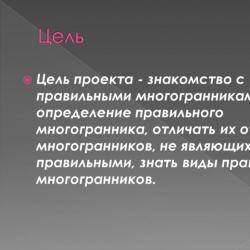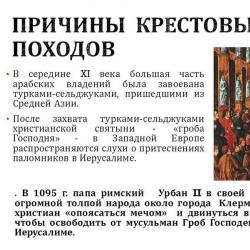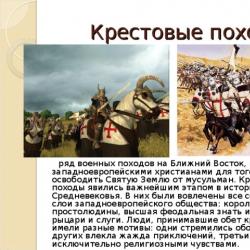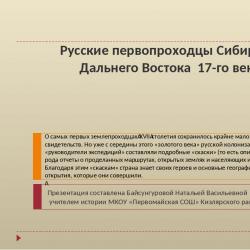Regular polyhedra presentation. Presentation on the topic "regular polyhedra" - presentation. All information taken from
Definition. A convex polyhedron is called
correct if all its faces are
equal regular polygons and
each of its vertices converges the same
the same number of ribs. correct
there are only five polyhedra: tetrahedron,
hexahedron, octahedron, dodecahedron, icosahedron.
Tetrahedron
Octahedron
Tetrahedron - the simplest polyhedron, faces
which are four triangles. At
tetrahedron 4 faces, 4 vertices and 6 edges. tetrahedron, u
all of whose faces are equilateral
triangles is called
correct. Do the right
tetrahedron all dihedral angles at edges and
All triangular vertex angles are equal.
Octahedron - has 8 triangular faces, 12 edges, 6
vertices, 4 edges meet at each vertex.
Examples of regular polyhedra:
icosahedronCube
Icosahedron - regular convex
polyhedron, twenty-sided. Each of the 20
faces is
equilateral triangle. The number of edges is
30, number of vertices - 12. The icosahedron has
59 star shapes.
The cube is a regular polyhedron, each face
which is a square. Peaks -
8, Edges - 12, Facets - 6.
Examples of regular polyhedra:
DodecahedronDodecahedron - made up of
twelve correct
pentagons that are his
faces.
Each vertex of the dodecahedron
is the vertex of three regular
pentagons. Thus,
dodecahedron has 12 faces
(pentagonal), 30 ribs and 20
vertices (3 edges converge in each).
Characteristics and formulas:
Elements of symmetry of a regular tetrahedron:
A regular tetrahedron has no center
symmetry. But it has three axes
symmetry and six planes
symmetry.
Elements of symmetry of a regular octahedron:
A regular octahedron has a centersymmetry - the point of intersection of its axes
symmetry. Three of 9 planes
symmetries of the tetrahedron pass through
every 4 vertices of the octahedron lying in
one plane. six planes
symmetries pass through two vertices,
not belonging to the same face, and
midpoints of opposite ribs.
Elements of symmetry of a regular icosahedron:
A regular icosahedron has 15 axessymmetries, each of which passes
through the midpoints of opposite
parallel ribs. Intersection point
of all axes of symmetry of the icosahedron is
its center of symmetry. planes
symmetry also 15. Planes
symmetries pass through four
vertices that lie in the same plane, and
midpoints of opposite parallel
ribs.
Cube symmetry elements:
The cube has one center of symmetry -the point of intersection of its diagonals, also
9 axes pass through the center of symmetry
symmetry. Planes of symmetry of a cube
also 9 and they either pass through
opposite ribs.
Elements of symmetry of a regular dodecahedron:
A regular dodecahedron has a centersymmetry and 15 axes of symmetry. Each
from the axes passes through the middle
opposite parallel edges.
Dodecahedron has 15 planes
symmetry. Any of the planes
symmetry runs in each face
through top and middle
opposite rib.
All information taken from:
http://licey102.k26.ru/http://math4school.ru
wikipedia.org
Textbook for grades 10-11 in geometry

One of the oldest references to regular polyhedra is in Plato's treatise (BC) "Timaus". Therefore, regular polyhedra are also called Platonic solids (although they were known long before Plato). Each of the regular polyhedra, and there are five in total. Plato associated with four "earthly" elements: earth (cube), water (icosahedron), fire (tetrahedron), air (octahedron), as well as with the "unearthly" element - sky (dodecahedron).

A regular polyhedron, or Platonic solid, is a convex polyhedron with the greatest possible symmetry. A polyhedron is called regular if: it is convex all its faces are equal regular polygons at each of its vertices the same number of faces converges all its dihedral angles are equal







We note an interesting fact related to the hexahedron (cube) and octahedron. A cube has 6 faces, 12 edges and 8 vertices, while an octahedron has 8 faces, 12 edges and 6 vertices. That is, the number of faces of one polyhedron is equal to the number of vertices of the other and vice versa. The cube and hexahedron are said to be dual to each other. This is also manifested in the fact that if you take a cube and build a polyhedron with vertices in the centers of its faces, then, as you can easily see, you get an octahedron. The reverse is also true - the centers of the faces of the octahedron serve as the vertices of the cube. This is precisely the duality of the octahedron and the cube (fig.). It is easy to figure out that if we take the centers of the faces of a regular tetrahedron, then we again get a regular tetrahedron (Fig.). Thus, the tetrahedron is dual to itself.


The famous mathematician and astronomer Kepler built a model of the solar system as a series of regularly inscribed and described regular polyhedra and spheres. What is the order of the arrangement of the planets (in accordance with the "requirements" of regular polyhedra) obtained by Kepler? A cube was inscribed in the sphere of the orbit of Saturn, and the sphere of the orbit of Jupiter was inscribed in it; a tetrahedron fit into this sphere, into it - the sphere of the orbit of Mars; further: dodecahedron - sphere of the Earth's orbit - icosahedron - sphere of the orbit of Venus - octahedron - sphere of the orbit of Mercury.



Back forward
Attention! The slide preview is for informational purposes only and may not represent the full extent of the presentation. If you are interested in this work, please download the full version.
Lesson Objectives:
- to acquaint students with the concept of a regular polyhedron and with five types of regular polyhedra,
- to promote the formation of skills in the use of computer technology in the study of new material
- to promote the development of independent activity, the ability to compare, generalize.
Lesson equipment:
- Multimedia projector, screen, computers
- Presentation "Regular polyhedra"
- Models of Regular Polyhedra
- Cards - tasks "Tasks according to finished drawings" - Annex 1
- Table "Regular polyhedra"
- Handout "Crossword" - Appendix 2
DURING THE CLASSES
1. Organizational moment(5 minutes.)
Target setting of the lesson (Message of the topic, purpose of the lesson and work order)
The section on regular polyhedra is descriptive in nature, one lesson is allotted for its study. The material on regular polyhedra significantly supplements and logically completes the section "Polyhedra". In fact, the classification of polyhedra continues here; regular ones are distinguished from convex polyhedra.
2. Learning new material(15 minutes.)
The teacher needs to organize the work in such a way that the new concept of "regular polyhedron" is formed on the basis of students' already established ideas about regular prisms, pyramids and regular polygons.
The existence of only five kinds of regular polyhedra is reported without proof. The proof of this theorem can be considered in the classes of the corresponding optional course.
Presentation "Regular polyhedra"
The presentation was prepared on the topic "Regular polyhedra" for students in grades 10-11 of general education schools and students of vocational schools. The material offers historical information about regular polyhedra, their features, properties. Examples are given from the surrounding world where polyhedra can be found. The presentation can be used in geometry lessons, elective courses, as well as extracurricular activities in mathematics.
Using a presentation in a lesson allows you to save time, make the study of the material more interesting, colorful, and unusual.
Slides 2, 3- The definition of a regular polyhedron is introduced and students self-control the assimilation of the definition.
“Regular polyhedra are defiantly few, - L. Carroll once wrote, - but this detachment, very modest in number, managed to get into the very depths of various sciences.
Slides 4-9- The existence of only five types of regular polyhedra is reported, and for each of the polyhedra its drawing, three-dimensional image, surface development and basic properties are presented.
Since ancient times, polyhedrons have attracted the attention of people with their beauty, perfection and harmony.
Slide 10– Historical reference - information from the history of Plato and regular polyhedra.
slide 11– Elements of regular polyhedra, dependence between elements. Euler's theorem.
slide15— Leonhard Euler
Special interest in regular polyhedra is associated with the beauty and perfection of their forms. They are quite common in nature.
Slides 12, 13– Regular polyhedra in nature, in particular, in crystallography.
Slide 14– Conclusion and homework
After studying the new material, the assimilation of the material is checked using wireframe and planar models of polyhedra and the table "Regular polyhedra". After that, students begin to solve problems according to the finished drawings.
3. Problem solving(17 min.) – Annex 1
№1. Find the height of a regular tetrahedron with an edge of 10 cm.

Given: ABCD is a regular tetrahedron,
AB = 10 cm
Find: the height of the tetrahedron
Solution.
1) AF is the median ΔABС, so BF = ______
2) From ΔABF, according to the theorem _______, we find AF
AF 2 = AB 2 - BF 2
3) O divides the segment AF in a ratio of 2: 1, therefore AO \u003d _____________________
4) From ΔADO by the Pythagorean theorem we find DO
DO2 = ____________
DO = ____________
Answer: ______cm
No. 2. Solve the problem using the solution plan
The crystal has the shape of an octahedron, consisting of two regular pyramids with a common base, the edge of the base of the pyramid is 6 cm. The height of the octahedron is 14 cm. Find the lateral surface area of the crystal.
 Solution.
Solution.
1) Sside = 2 Spir = p ∙ SK (where SK is the apothem, p is the semiperimeter of ABCD)
2) Find OK _________________________
3) Find SO ____________________________
______________________________________
4) Find SK ____________________________
______________________________________
5) Calculate Sside ______________________
______________________________________
№3. Prove that the ends of two non-parallel diagonals of opposite faces of a cube are vertices of a tetrahedron.

4. Additional task.
Crossword (work in pairs) Appendix 2
Depending on the level of preparedness of a class or group of students, you can offer them additional task in the form of a crossword. If a class or group has low mathematical abilities, then a crossword puzzle can be offered for solution in the next lesson as a repetition of previously studied material.
5. Lesson summary(5 minutes.)
The outcome of the lesson provides for a discussion with students at the end of the lesson not only of the success of the implementation of the set goals, but also what they liked (did not like) and why, what was useful for him personally, what he would like to repeat, what to change in future work.
6. Homework(3 min.)
Make scans of the surfaces of regular polyhedra (regular tetrahedron, cube, octahedron).
Answer questions No. 30, 31 p. 243, Pogorelov A. V. "Geometry 10-11"
Solve problems No. 57 p. 249, No. 70 p. 248
Homework includes solving problems and building sweeps and models of regular polyhedra. Students themselves choose which of the considered polyhedra they will perform (you can “split” the class or group into five groups according to the number of types of regular polyhedra and offer each group to make only one of the regular polyhedra).
slide 2
Introduction. Historical reference. Tetrahedron. Cube (hexahedron). Octahedron. Dodecahedron. Icosahedron. Check yourself. Sources.
slide 3
Introduction.
A convex polyhedron is called regular if its faces are regular polygons with the same number of sides and the same number of edges converge at each vertex of the polyhedron. There are five types of regular convex polyhedra: tetrahedron, cube, octahedron, dodecahedron, icosahedron.
slide 4
HISTORICAL REFERENCE.
All these types of polyhedra were known in ancient Greece. Book XIII of Euclid's Elements is devoted to these beautiful bodies. They are also called the solids of Plato. They occupied a prominent place in his idealistic picture of the world. Four of them represent four "essences" or "elements" in it: the tetrahedron is fire, the icosahedron is water, the cube is earth, the octahedron is air. The dodecahedron embodied "everything that exists", symbolized the whole worldview, was revered as the most important.
slide 5
TETRAHEDRON.
"Tetrahedron" in literal translation from Greek means "tetrahedron." A regular tetrahedron has faces - regular triangles; three edges converge at each vertex. A tetrahedron is a triangular pyramid with all edges equal.
slide 6
HEXAHEDR.
"Hexahedron" in Greek means "hexahedron". In a cube, all faces are squares; three edges converge at each vertex. The cube is a rectangular parallelepiped with equal edges.
Slide 7
OCTAHEDRON.
"Octahedron" in Greek means "octahedron". The octahedron faces are regular triangles, but unlike the tetrahedron, four edges converge at each of its vertices.
Slide 8
DODECAHEDRON.
"Dodecahedron" in Greek means "dodecahedron". The faces of the dodecahedron are regular pentagons. Three edges converge at each vertex.
Slide 9
ICOSAHEDRON.
"Icosahedron" in Greek means "twenty-sided". The icosahedron faces are regular triangles, but unlike the tetrahedron and octahedron, five edges converge at each vertex.
slide 1
slide 2
 SYMMETRY IN SPACE “Symmetry is the idea through which a person tried to comprehend and create order, beauty and perfection” (G. Weil) Symmetry (“proportionality”) is correspondence, immutability (invariance) manifested during any transformations. So, for example, the spherical symmetry of a body means that the appearance of the body will not change if it is rotated in space through arbitrary angles, keeping one point in place. "Vitruvian Man" by Lenardo Da Vinci (1490, Venice)
SYMMETRY IN SPACE “Symmetry is the idea through which a person tried to comprehend and create order, beauty and perfection” (G. Weil) Symmetry (“proportionality”) is correspondence, immutability (invariance) manifested during any transformations. So, for example, the spherical symmetry of a body means that the appearance of the body will not change if it is rotated in space through arbitrary angles, keeping one point in place. "Vitruvian Man" by Lenardo Da Vinci (1490, Venice)
slide 3
 SYMMETRY IN SPACE Points A and A1 are called symmetrical about the point O (center of symmetry) if O is the midpoint of the segment AA1. Point O is considered symmetrical to itself. A A1
SYMMETRY IN SPACE Points A and A1 are called symmetrical about the point O (center of symmetry) if O is the midpoint of the segment AA1. Point O is considered symmetrical to itself. A A1
slide 4
 SYMMETRY IN SPACE Points A and A1 are called symmetrical with respect to a straight line (axis of symmetry) if the straight line passes through the middle of the segment AA1 and is perpendicular to this segment. Each point of the line a is considered symmetrical to itself. A1
SYMMETRY IN SPACE Points A and A1 are called symmetrical with respect to a straight line (axis of symmetry) if the straight line passes through the middle of the segment AA1 and is perpendicular to this segment. Each point of the line a is considered symmetrical to itself. A1
slide 5
 SYMMETRY IN SPACE Points A and A1 are called symmetrical with respect to a plane (plane of symmetry) if this plane passes through the middle of segment AA1 and is perpendicular to this segment. Each point of the plane is considered symmetrical to itself.
SYMMETRY IN SPACE Points A and A1 are called symmetrical with respect to a plane (plane of symmetry) if this plane passes through the middle of segment AA1 and is perpendicular to this segment. Each point of the plane is considered symmetrical to itself.
slide 6
 SYMMETRY IN SPACE A point (line, plane) is called the center (axis, plane) of symmetry of a figure if each point of the figure is symmetrical with respect to it to some point of the same figure. If a figure has a center (axis, plane) of symmetry, then they say that it has central (axial, mirror) symmetry
SYMMETRY IN SPACE A point (line, plane) is called the center (axis, plane) of symmetry of a figure if each point of the figure is symmetrical with respect to it to some point of the same figure. If a figure has a center (axis, plane) of symmetry, then they say that it has central (axial, mirror) symmetry
Slide 7
 EXAMPLES OF SYMMETRY OF PLANE FIGURES A parallelogram has only central symmetry. Its center of symmetry is the intersection point of the diagonals. An isosceles trapezoid has only axial symmetry. Its axis of symmetry is a perpendicular drawn through the midpoints of the bases of the trapezoid. The rhombus has both central and axial symmetry. Its axis of symmetry is any of its diagonals; center of symmetry - the point of their intersection
EXAMPLES OF SYMMETRY OF PLANE FIGURES A parallelogram has only central symmetry. Its center of symmetry is the intersection point of the diagonals. An isosceles trapezoid has only axial symmetry. Its axis of symmetry is a perpendicular drawn through the midpoints of the bases of the trapezoid. The rhombus has both central and axial symmetry. Its axis of symmetry is any of its diagonals; center of symmetry - the point of their intersection
Slide 8
 REGULAR POLYHEDRALS - 5 PLATONIAN BODIES The inhabitants of even the most distant galaxy cannot play dice that have the shape of a regular convex polyhedron unknown to us. M. Gardner A convex polyhedron is called regular if all its faces are equal regular polygons and the same number of edges converge at each of its vertices. Also, all edges of a regular polygon are equal, as are all dihedral angles containing two faces with a common edge. There is no regular polyhedron whose faces are n-gons for n > or = 6!
REGULAR POLYHEDRALS - 5 PLATONIAN BODIES The inhabitants of even the most distant galaxy cannot play dice that have the shape of a regular convex polyhedron unknown to us. M. Gardner A convex polyhedron is called regular if all its faces are equal regular polygons and the same number of edges converge at each of its vertices. Also, all edges of a regular polygon are equal, as are all dihedral angles containing two faces with a common edge. There is no regular polyhedron whose faces are n-gons for n > or = 6!
Slide 9
 REGULAR TETRAEDER Composed of four equilateral triangles. Each of its vertices is a vertex of three triangles. The sum of the plane angles at each vertex is exactly 180°. Elements of symmetry: The tetrahedron has no center of symmetry, but has 3 axes of symmetry and 6 planes of symmetry. S total Volume Height Vertices – 4 Faces – 6 Edges – 4
REGULAR TETRAEDER Composed of four equilateral triangles. Each of its vertices is a vertex of three triangles. The sum of the plane angles at each vertex is exactly 180°. Elements of symmetry: The tetrahedron has no center of symmetry, but has 3 axes of symmetry and 6 planes of symmetry. S total Volume Height Vertices – 4 Faces – 6 Edges – 4
slide 10
 CUBE Composed of six squares. Each vertex of the cube is the vertex of three squares. The sum of the plane angles at each vertex is exactly 270°. 6 faces, 8 vertices and 12 edges Elements of symmetry: The cube has a center of symmetry - the center of the cube, 9 axes and planes of symmetry R opis. env. S full r fit env
CUBE Composed of six squares. Each vertex of the cube is the vertex of three squares. The sum of the plane angles at each vertex is exactly 270°. 6 faces, 8 vertices and 12 edges Elements of symmetry: The cube has a center of symmetry - the center of the cube, 9 axes and planes of symmetry R opis. env. S full r fit env
slide 11
 REGULAR OCTAHEDRON Composed of eight equilateral triangles. Each vertex of the octahedron is a vertex of four triangles. The sum of the plane angles at each vertex is 240°. Elements of symmetry: The octahedron has a center of symmetry - the center of the octahedron, 9 axes of symmetry and 9 planes of symmetry 8 faces 6 vertices 12 edges
REGULAR OCTAHEDRON Composed of eight equilateral triangles. Each vertex of the octahedron is a vertex of four triangles. The sum of the plane angles at each vertex is 240°. Elements of symmetry: The octahedron has a center of symmetry - the center of the octahedron, 9 axes of symmetry and 9 planes of symmetry 8 faces 6 vertices 12 edges






